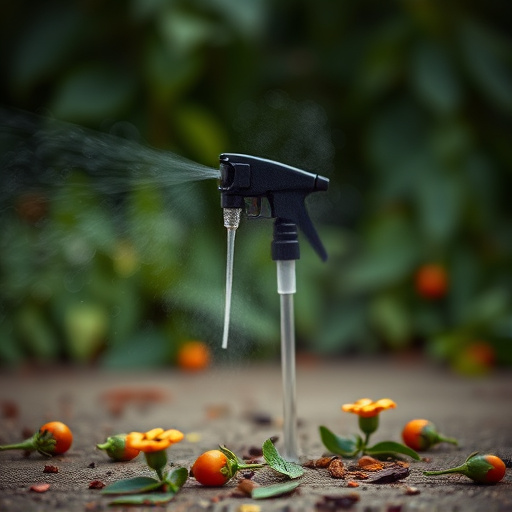OC spray effectiveness hinges on capsaicin concentration levels, ranging from 1.5% to 2% in standard canisters, with specialized units employing up to 5%. Weather conditions and distance impact range and persistence. Concentrations above 2% increase risk of severe irritation, underscoring the need for training, safety gear, and de-escalation protocols for safe deployment.
In the realm of riot control, a crucial tool often employed is the pepper spray dispenser unit. This article delves into the intricacies of these devices, focusing on key aspects like understanding the power of OC (Oleoresin Capsaicin) spray and its capsaicin concentration levels, the inner workings of dispenser units, and factors that impact their effectiveness. Additionally, we explore safety considerations to ensure responsible use in volatile situations.
- OC Spray: Understanding Capsaicin Concentration
- How Pepper Spray Dispenser Units Work
- Factors Influencing Spray Effectiveness
- Safety Considerations for Riot Control Devices
OC Spray: Understanding Capsaicin Concentration
OC spray, or Oleoresin Capsaicin (OC) spray, is a non-lethal weapon designed to incapacitate individuals through the irritation of eyes and airways. The effectiveness of OC spray largely depends on its capsaicin concentration levels. This chemical compound is derived from chili peppers and is responsible for the burning sensation it induces.
Concentration levels are typically measured in percent or milliliters per liter (mL/L). In law enforcement, standard OC spray canisters contain capsaicin concentrations ranging from 1.5% to 2%. Higher concentrations up to 5% or more are also available for specialized units, offering increased effectiveness but also greater risk of side effects and injury if not used properly. Understanding the capsaicin concentration is crucial in knowing the expected impact and duration of the spray, ensuring its safe and effective deployment during riot control situations.
How Pepper Spray Dispenser Units Work
Pepper spray dispenser units are designed to discharge a potent chemical compound known as oleoresin capsicum (OC), which is derived from chili peppers. When activated, the unit releases a stream of OC spray, containing capsaicin at specific concentration levels, typically measured in percent or milliliters per liter. This powerful agent irritates the eyes, nose, and respiratory system, temporarily disabling an individual and providing crucial time for law enforcement to control and manage chaotic situations.
The mechanism involves a pressurized container that houses the OC solution, along with a nozzle or applicator tip. A trigger mechanism, often a simple pump or squeeze action, releases the pressure, causing the OC spray to expel at high velocity. The concentration levels play a significant role in determining the spray’s effectiveness and range, ensuring it can reach and affect targets at various distances while minimizing off-target impact on bystanders.
Factors Influencing Spray Effectiveness
The effectiveness of riot control pepper spray is influenced by several key factors, with one of the most critical being the capsaicin concentration levels present in the spray solution. OC spray, a common type used for crowd control, typically contains capsaicin in concentrations ranging from 1% to 2%. This compound is derived from chili peppers and is responsible for the burning sensation it produces upon contact with skin or eyes. Higher capsaicin concentrations generally result in more intense effects, rendering individuals temporarily incapacitated.
Other factors that play a role include weather conditions, such as temperature and humidity, which can affect the spray’s range and persistence. Wind direction and speed can also impact the spray’s path and dispersion, making it more or less effective at neutralizing potential rioters. Additionally, the distance between the dispenser unit and the target plays a significant part in determining the spray’s overall success. Close-range applications tend to yield quicker and more severe outcomes compared to those from farther distances.
Safety Considerations for Riot Control Devices
When it comes to riot control devices like pepper spray dispenser units, safety considerations are paramount. These tools are designed for law enforcement and security personnel to manage and disperse crowds during civil unrest or high-tension situations; however, they must be used responsibly to minimize harm. One key aspect is understanding the capsaicin concentration levels in OC (Oleoresin Capsaicin) spray. This chemical compound, found in chili peppers, is what makes pepper spray effective. Manufacturers typically specify the percentage of capsaicin in their products, ranging from 0.5% to 2%. Higher concentrations offer more potent effects but also increase the risk of severe irritation and adverse reactions, especially in individuals with respiratory conditions or sensitive skin.
Therefore, proper training is essential for operators to ensure they understand the spray’s range, wind conditions, and safe application methods. Safety gear, such as protective eyewear and clothing, should be worn during use to guard against direct contact with the spray. Additionally, having a clear protocol for de-escalation and crowd management before resorting to riot control devices is crucial. These precautions help balance public safety with the effectiveness of these tools, making them valuable assets in maintaining order while mitigating potential harm.
Riot control pepper spray dispenser units, such as those employing OC spray with specific capsaicin concentration levels, play a critical role in maintaining public safety during volatile situations. Understanding how these devices work, their effectiveness factors, and safety considerations is essential for optimal deployment. By leveraging the power of capsaicin concentration levels, law enforcement can effectively navigate challenging environments while prioritizing the well-being of both officers and civilians.
